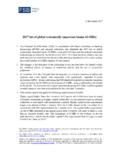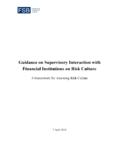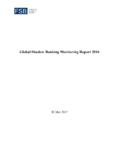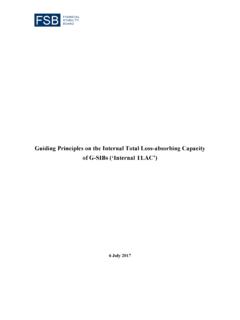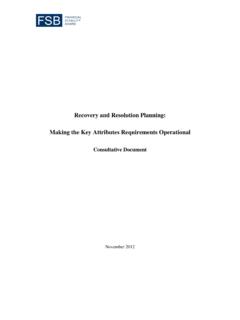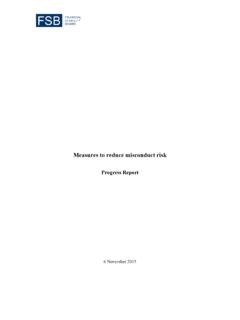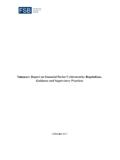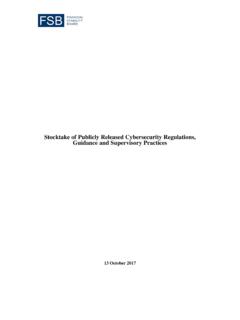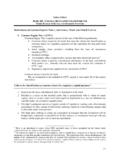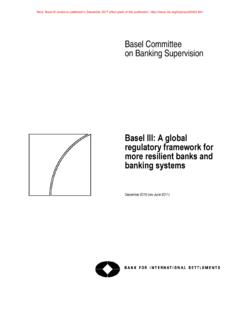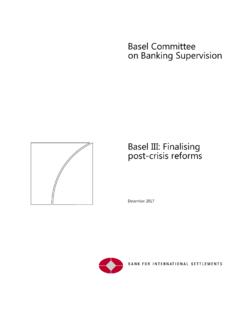Transcription of Implementation and Effects of the 3 July 2017 3 Annual Report
1 Implementation and Effects of the G20 Financial Regulatory Reforms 3 July 2017 3rd Annual Report The Financial Stability Board (FSB) is established to coordinate at the international level the work of national financial authorities and international standard-setting bodies in order to develop and promote the Implementation of effective regulatory, supervisory and other financial sector policies. Its mandate is set out in the FSB Charter, which governs the policymaking and related activities of the FSB. These activities, including any decisions reached in their context, shall not be binding or give rise to any legal rights or obligations under the FSB s Articles of Association. Contacting the Financial Stability Board Sign up for e-mail alerts: Follow the FSB on Twitter: E-mail the FSB at: @FinStbBoard Copyright 2017 Financial Stability Board.
2 Please refer to: TABLE OF CONTENTS Page Executive Summary .. 1 Table on Implementation of reforms in priority areas by FSB jurisdictions (as of 30 June 2017) 3 1. Introduction .. 6 2. Implementation status .. 7 Building resilient financial institutions .. 7 Ending too-big-to-fail .. 10 Making derivatives markets safer .. 12 Transforming shadow banking into resilient market-based finance .. 15 Progress in other reform areas .. 17 Strengthening adherence to international financial standards .. 18 Key Implementation challenge: global regulatory cooperation .. 19 3. OTC derivatives market reforms .. 21 4. Shadow banking assessment .. 24 5. Overall Effects of reforms .. 27 Building a more resilient financial system .. 27 Supporting sound financial intermediation .. 30 6. Areas for ongoing attention .. 34 Maintaining an open and integrated global financial system .. 34 Market 38 Effects of reforms on Emerging Market and Developing Economies (EMDEs).
3 43 7. FSB evaluation framework .. 46 Annex 1: Monitoring forward planner .. 48 Annex 2: Sources of information .. 49 Abbreviations .. 51 1 Executive Summary Ten years have passed since the onset of the worst financial crisis since the Great Depression. In 2009, the G20 launched a comprehensive programme of reforms, coordinated through the FSB, to increase the resilience of the global financial system while preserving its open and integrated structure. Implementation progress continues but is uneven across the four core areas: Building resilient financial institutions Implementation of Basel III capital and liquidity standards has generally been timely, and banks continue to build higher and better quality capital and liquidity buffers. More work is needed to implement other Basel III standards, while some advanced economies rules are not fully consistent with the Basel framework.
4 Ending too-big-to-fail Implementation of higher loss absorbency, Total Loss-Absorbing Capacity (TLAC) and more intensive supervision is advancing well for global systemically important banks (G-SIBs). But progress has been slower on other resolution reforms over the past year and substantial work remains to build effective resolution regimes and to operationalise resolution plans for cross-border firms. Making derivatives markets safer Implementation of these reforms is now well progressed, although this has taken longer than originally intended. Overall, Implementation is most advanced for trade reporting, but significant challenges remain for its effective use. Central clearing frameworks as well as margin and interim capital requirements have been implemented in most FSB jurisdictions, while platform trading frameworks have been implemented in half of FSB jurisdictions.
5 Transforming shadow banking into resilient market-based finance Implementation of reforms on oversight and regulation of shadow banking entities, including money market funds, securities financing transactions and securitisation, is progressing but remains at a relatively early stage. The evidence on Effects of reforms to date shows that higher resilience is being achieved without impeding the supply of credit to the real economy: The core of the banking system is significantly more resilient, with large internationally active banks continuing to build capital and liquidity buffers. The financial system is more diversified, including through the growth in market-based finance. Growth in total credit and bank lending has resumed in all regions, albeit at different paces, while the cost of financing has remained low. Exceptionally accommodative monetary policies have contributed to this outcome.
6 However, authorities need to remain vigilant in a number of areas: Maintaining an open and integrated global financial system International bank lending, particularly by European banks, has declined since the crisis and its structure has shifted towards more stable regionally funded lending. Financing through international debt markets has continued to grow, and there is greater use of global infrastructures for trading, clearing and settlement. Nonetheless, the risks of geographic market fragmentation remain and should be monitored. Market liquidity There continues to be limited evidence of a broad reduction in market liquidity in normal times and the reforms have lowered the likelihood that a reduction in market liquidity could result in wider financial stability problems. The FSB continues to monitor fixed income and 2 derivatives market liquidity (including banks role as market intermediaries) and will further analyse its resilience under stressed conditions.
7 Effects of reforms on emerging market and developing economies (EMDEs) Some EMDEs continue to Report Implementation challenges and concerns from the reduction in global banks activity in their domestic markets. To date, however, these do not seem to have significantly impacted EMDEs overall credit growth. Over the past year, the FSB completed assessments in two core reforms: OTC derivatives While the long-term economic Effects of the reforms remain difficult to assess, progress has been made toward meeting the G20 objectives. Meaningful progress has been made toward mitigating systemic risk. Central clearing is simplifying much of the previously complex and opaque web of derivatives exposures, and central counterparties (CCPs) are more resilient. In addition, more collateral is in place in the system. There is progress in improving transparency through use of trade repositories (TRs) and platform trading.
8 International work is taking place to improve the resilience, recovery planning and resolvability of CCPs; improve data quality and remove legal barriers to reporting and accessing TR data; and evaluate the interaction of reforms on incentives to clear OTC derivatives centrally. Shadow banking The aspects of shadow banking that contributed to the financial crisis have declined significantly and generally no longer pose financial stability risks. Reforms have also contributed to a reduction in vulnerabilities in areas such as money market funds and repos. But investment funds have grown, underscoring the importance of effective operationalisation and Implementation of policies agreed to address their structural vulnerabilities, and new forms of shadow banking may develop. While no new stability risks that would warrant additional regulatory action at the global level have been identified, work is needed by FSB jurisdictions to implement fully the agreed policy recommendations and enhance data collection and analysis to capture emerging risks in a timely manner.
9 With the main elements of the post-crisis reforms agreed and Implementation of many core reforms underway, more detailed analysis of the Effects of those reforms is becoming possible. The FSB, in collaboration with the SSBs, has developed a framework for the post- Implementation evaluation of the Effects of G20 reforms. The framework, which will be progressively applied in the coming years and enhanced as more experience is gained, will guide analyses of whether the reforms are achieving their intended outcomes, and help to identify material unintended consequences that should be addressed, without compromising on the objectives of the reforms. G20 Leaders continued support is needed to implement fully the agreed reforms, and to reinforce global regulatory cooperation by: revising legal frameworks to facilitate cooperation ( for sharing information among authorities on resolution and for removing legal barriers to reporting OTC derivatives to TRs and authorities access to TR-held data); encouraging full and consistent Implementation of standards to support a level playing field and reduce regulatory arbitrage opportunities; participating in post- Implementation evaluations of the Effects of the G20 financial regulatory reforms using the FSB s evaluation framework; and considering how the progress made in agreeing and implementing common standards and enhancing cooperation and coordination can best be leveraged to preserve an open and integrated system.
10 3 Table on Implementation of reforms in priority areas by FSB jurisdictions (as of 30 June 2017) The table provides a snapshot of the status of Implementation progress by FSB jurisdiction across priority reform areas, based on information collected by FSB and standard-setting bodies (SSBs) monitoring mechanisms. The colours and symbols in the table indicate the timeliness of Implementation . For Basel III, the letters indicate the extent to which Implementation is consistent with the international standard. For trade reporting, the letters indicate to what extent effectiveness is hampered by identified obstacles. Reform Area Basel III^ Compen-sation Over-the-counter (OTC) derivatives (as of 30 June 2017) Resolution Shadow banking Risk-based capital Liquidity coverage ratio (LCR) Higher loss absor-bency for G-SIBs (home jurisdi-ctions) Require-ments for D-SIBs Leverage ratio Net Stable Funding Ratio (NSFR) Trade reporting Central clearing Platform trading Margin Minimum TLAC require-ment for G-SIBs (home jurisdi-ctions) Transfer / bail-in / tempora-ry stay powers for banks Recovery and resolution planning for systemic banks Transfer / bridge / run-off powers for insurers Money market funds (MMFs) Securi-tisation Agreed phase-in (completed) date 2013 (2019) 2015 (2019) 2016 (2019) 2016 2018 2018 end-2012 end-2012 end-2012 2016 (2020) 2019/2025 (2022/2028)
